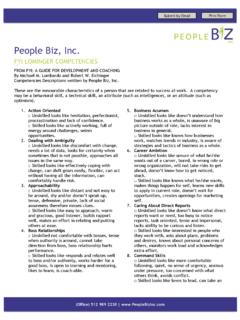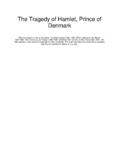Transcription of An assessment of where OECD countries stand
1 MEASURING DISTANCE TO THE SDG TARGETSAn assessment of where OECD countries standJune PEOPLEPLANETPROSPERITYPEACEPARTNERSHIPD esirable levels of achievement by 20301: Poverty2: Food3: Health4: Education5: Gender Equality6: Water7: Energy8: Economy9: Infrastructure10: Inequality11: Cities12: Sustainable Production13: Climate14: Oceans15: Biodiversity16: Institutions17: ImplementationGoals1 EXECUTIVE SUMMARY 2030 Agenda for Sustainable Development, adopted by world leaders at the UnitedNations on 25 September 2015, sets out an ambitious plan of action for people, planet and prosperity, with the overarching objective of leaving no one behind. At its core are 17 Sustainable Development Goals (SDGs) comprising 169 targets. Study of the distances from the SDGs of selected OECD countries is designed to helpgovernments as they consider developing national action plans, as well as to contribute to SDG mainstreaming across different OECD Directorates.
2 It leverages the wealth of statistical data collected by OECD members and harmonised through OECD tools and processes. This booklet updates the Pilot Study, published by OECD in July 2016, by offering a wider set of indicators and more complete coverage of the Agenda 2030 targets, as well as a refined methodology for assessing distance to those targets. Study uses the latest information on various indicators available in OECD databases toestablish countries distances from individual targets, and presents results for a number of countries . These starting positions are measured in terms of the distance to be travelled by 2030. This requires setting end-values for the targets to be achieved by 2030. The Study uses a flexible approach to target setting, with appropriate consideration being given to values specified either in the 2030 Agenda or in other international commitments, but also using the current range of OECD performance as a rating scale where no such benchmarks have been enunciated.
3 As a reference the global indicator set endorsed by the UN Statistical Commission atits 47th session, OECD indicators have been selected based on criteria of relevance, ability to differentiate countries performance, availability and statistical quality. Applying these criteria, this document identifies 131 indicators covering 98 targets spanning all 17 Goals. It is, however, clear that many SDG targets cannot be currently measured adequately through data routinely collected by the OECD, and that significant statistical work is needed to fill some of these gaps. The OECD is well positioned to advance this agenda, given its expertise in developing policy indicators and in assessing interconnectedness and policy coherence.
4 Order to help interested countries explore the trans-boundary effects or contributions oftheir policies and development patterns, this Study also proposes an initial assessment of countries global contributions ( aid flows to less developed countries or consumption-based carbon dioxide emissions) to meeting some of the targets in the 2030 Agenda. the assessment of starting positions has been undertaken at target level, the results canalso be considered by Goal as well as through a global contribution lens. On average, OECD countries are currently closest to reaching targets related to water, climate, biodiversity, cities, poverty and oceans. They have the greatest distance to travel in relation to gender equality, education, the economy and jobs, and institutions.
5 Indicators can also be aggregated by the 5 Ps in the 2030 Agenda: People, Planet, Prosperity, Peace and Partnership. Based on this breakdown, OECD average scores are best on Planet, and Partnership, to a lesser extent on Prosperity, with People and Peace lagging behind. 2 is nonetheless important to underscore that this assessment is based only on what can bemeasured today. The selected indicators enable only 57% of all the SDG targets to be evaluated, and coverage is unequal across goals and the 5Ps. For example, while health and education have at least one indicator per target, oceans are covered in a very limited way. Similarly, while over 80% of the targets in the People category are covered by at least one indicator, this is true for fewer than 40% of the targets in the Planet category.
6 Given the limitations of current data, assessments of relative performance across the goals and 5Ps should be regarded as preliminary, and may change as more indicators become available in the future. variation in countries distance to travel across both goals and targets, as well as thevariation in data coverage, suggest that national priorities for implementing the SDG agenda should be set at target level, rather than at the goal or 5P level. , this Study shows that, to implement the 2030 Agenda, countries may need todevelop additional indicators and evidence to identify and track progress on policies that drive outcomes at the country level and that have significant trans-boundary impacts.
7 3 TABLE OF CONTENTS Executive Summary .. 1 1. Introduction .. 4 2. Nature and purpose of the Study .. 9 3. Study methodology .. 9 4. Study findings .. 16 5. How participating countries have been using the Study .. 20 6. Conclusion .. 21 Annex I: OECD indicators used in this Study .. 23 Annex II: Selected country profiles .. 31 References .. 58 Tables Table 1. Comparison of the OECD well-being framework and the 2030 Agenda .. 7 Table 2. Types of SDG indicators and their 2030 13 Table 3. Pro s and cons of different normalisation procedures .. 15 Figures Figure 1. Summary of the Sustainable Development Goals .. 4 Figure 2. Share of targets covered by at least one indicator .. 11 Figure 3. Percentage of targets measured by at least one indicator.
8 12 Figure 4. Illustrating current and former normalisation procedures .. 14 Figure 5. OECD average results by Goal .. 16 Figure 6. How OECD countries vary in their distance to targets, by SDG Goal .. 17 Figure 7. How OECD countries vary in their distance to targets, by 5Ps .. 17 Figure 8. How OECD countries vary in their distance to targets in Goal 7- Energy .. 18 Figure 9. Average performance of OECD countries on some SDG targets pertaining .. to global 19 Figure 10. Observed and predicted fatal traffic accidents - Slovenia .. 19 Boxes Box 1. The OECD Action Plan on SDGs .. 5 Box 2. The OECD well-being framework and the 2030 Agenda .. 6 4 1. Introduction 10. On 25 September 2015, world leaders meeting in New York adopted United Nations Resolution 70/1, Transforming our World: the 2030 Agenda for Sustainable Development.
9 The Agenda is a plan of action for people, planet and prosperity , and also seeks to strengthen universal peace in larger freedom . 11. The core of the Agenda is a set of 17 Sustainable Development Goals comprising 169 targets that draw on a large number of previous international agreements, especially concerning development, the environment and human rights (Figure 1). The Goals are presented as integrated and indivisible, global in nature and universally applicable . The Agenda presents them as addressing the 5Ps: People (broadly corresponding to Goals 1-5), Planet (6, 12, 13, 14 and 15), Prosperity (7-11), Peace (16) and Partnership (17). 12. Still, this does not mean that every target applies to every country.
10 Rather: Targets are defined as aspirational and global, with each Government setting its own national targets guided by the global level of ambition but taking into account national circumstances. Each Government will also decide how these aspirational and global targets should be incorporated into national planning processes, policies and strategies. 1 Figure 1. The 17 Sustainable Development Goals Source: United Nations. 13. Once countries have decided their national targets, and how they will be integrated into national processes, they will need to decide on how to implement policy strategies to achieve those goals, and how to track progress in their implementation plans. The 2030 Agenda encourage[s] member states to conduct regular and inclusive reviews of progress at the national and sub-national levels , but leaves the modalities of this national review process to their discretion.
















